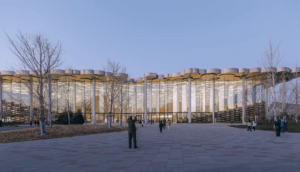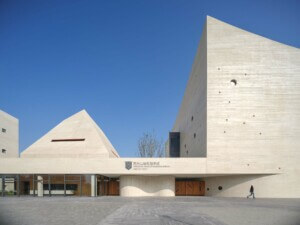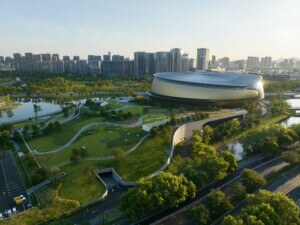“City-ness” is at the heart of the Bi-City Biennale of Urbanism\Architecture, which kicked off last Friday in Shenzhen, China. Titled Re-Living the City and curated by Aaron Betsky, Alfredo Brillembourg, Hubert Klumpner, and Doreen Heng Liu the event brought together architects, designers, urbanists, and makers on the site of the former Dacheng Flour Factory not far from Shekou Port.
Opening night culminated with giant animated graphics projected on the factory’s abandoned concrete silos, a dramatic light show that reflected the organizers and curators ambitious attempt to rethink how China, and especially still-booming Shenzhen, approaches continued urbanization. The industrial port area is primed for redevelopment and the biennial activities and adaptive reuse of the main five-story concrete building and adjacent structures seem poised to remake this part of the city into a hub a cultural activity based on tactical and informal urbanisms.
The curators divided the biennale into subthemes: Collage City 3D, PRD 2.0, Radical Urbanism, Social City, and Maker Maker, which are distributed across the site. The third floor of the former flour factory is dedicated to thematic and national pavilions. (It’s here that I co-curated with Tim Durfee an exhibition on behalf of Art Center’s Media Design Practices Program entitled Now, There: Scenes from the Post-Geographic City.)
While each thematic category manifests through distinctly different projects—Collage City for example featured Hood Design’s Symbiotic Village installation of hanging fish bowls, while Radical Urbanism presented a mural-like illustration from Interboro Partners’ Arsenal of Exclusion and Inclusion: The Battle for the Beach—there’s a shared emphasis on bottom-up urbanism, hands-on techniques, and citizen agency.
Or, as Betsky is quoted as saying in the catalog: “enough buildings, enough objects, enough images.”
His statement is certainly a provocation given Shenzhen’s skyline—at night the architectural products of the last 20 years are ablaze with LED light shows, screens, and advertisements. The curators ground their explorations in the here and now, emphasizing how the present offers future lessons for a “re-lived” urbanism. But given the recent Chinese edict “No more weird buildings,” one has to wonder if “enough” is enough to carry the next decades. Will the absence of formal agenda lead to a vacuum filled with banal buildings or instead offer space for these types of urbanisms to authentically emerge on their own?










